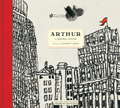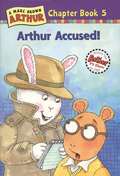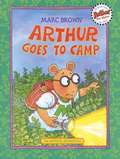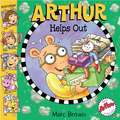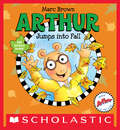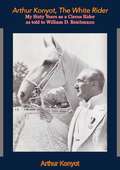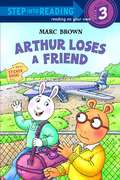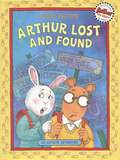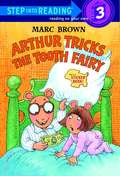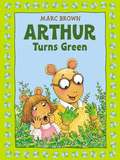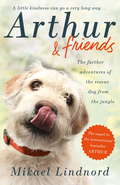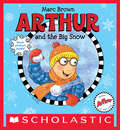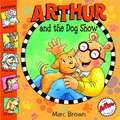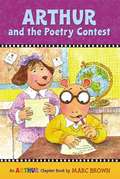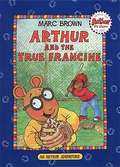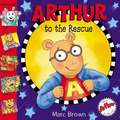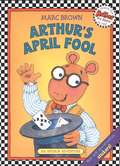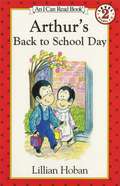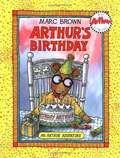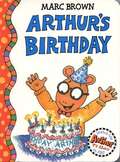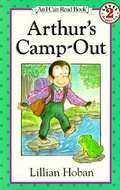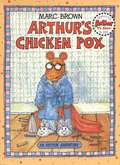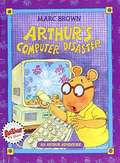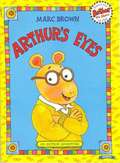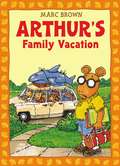- Table View
- List View
Arthur
by Everett Aison Rhoda LevineAfter a fine, green summer in Central Park, all the birds are preparing to fly south. Except for Arthur, that is. Arthur is off playing, gazing into a lake, dreaming of wider seas.And so Arthur is left behind. It begins to get cold. The trees are losing their leaves. Arthur feels uneasy and lonely, especially after his nest is scattered to the winds. Arthur must find a new home, and after he does--he settles down in a statue's open book--he discovers a new city, where he can play hide-and-seek in the steam from a manhole cover and feast with the pigeons on crumbs, and which soon brings other delightful surprises (and challenges): icicles, a great big sweet-smelling evergreen tree that is all lit up with people gathered around it to sing "Gloria" in the cold night, and snow--a whole winter wonderland! And then the trees begin to bud; the birds come back.... With Arthur as their guide through the city, children will find new poetry and beauty on every corner.
Arthur Accused! (A Marc Brown Arthur Chapter Book)
by Stephen Krensky Marc BrownArthur's friend Buster is searching for a crime to solve. When the quarters Arthur has collected for Mrs. MacGrady's charity drive mysteriously disappear, Buster is committed to cracking the case. Will Buster be able to prove Arthur's innocence so that he can attend the class picnic? For beginning readers, this suspenseful adventure will surely be a hit.
Arthur Goes to Camp
by Marc BrownPoor Arthur. He and the boys can't seem to do anything right at Camp Meadowcroak. Awful food, poison ivy, and losing to the girls in every sport are more than he can take. Arthur plots to run away just as the other campers plot to win the big scavenger hunt against their archrivals at Camp Horsewater. What happens when the two schemes collide makes a rousing finale to a funny, reassuring picture book. Arthur Goes to Camp brings more good laughs and learning to the growing number of Arthur fans.
Arthur Helps Out
by Marc BrownIt's Saturday and Arthur wants to play, but Mom and Dad want him to help with chores first.
Arthur Jumps into Fall
by Marc BrownArthur the aardvark can’t leave well enough alone in this autumn adventure—from the creative producer of PBS’s Peabody and Emmy Award-winning TV series.Arthur has a big job to do: raking all of the leaves in the backyard. He tries to focus, but jumping in the leaves is way more fun than raking them. How will he ever finish? Arthur will need some help from his friends for this task!
Arthur Konyot, The White Rider: My Sixty Years as a Circus Rider as told to William D. Reichmann
by Arthur KonyotHere is a life story in the great tradition—a brilliant chronicle of circus and horse show life by the celebrated equestrian showman Arthur Konyot, senior surviving member of a renowned Hungarian family of artistes and circus proprietors. Its colorful record of activity and adventure spans more than half a century, reaching from the golden age of the circus in Europe and America before the first World War down to the swiftly changing world of the circus and show ring of the late 1950s.
Arthur Loses a Friend
by Marc BrownBuster goes away for a month, and Arthur becomes sad and confused when he does not receive even one postcard from him.
Arthur Lost and Found
by Marc BrownArthur and Buster take the bus downtown together for the first time to go to Arthur's swimming lesson. During the ride, they fall asleep and miss their stop, winding up on the other side of town. Then they spend all their money on a snack of chocolate winkies and strawberry sodas. Will Arthur and Buster be able to put their heads together and find their way home? With characteristic humor, this Arthur Adventure will keep fans on the edge of their seats until Arthur and Buster make their way home safely.
Arthur Tricks the Tooth Fairy
by Marc BrownD. W. is jealous when her big brother Arthur loses a tooth and gets a visit from the Tooth Fairy. Arthur explains that the Tooth Fairy comes only when you lose a tooth and put it under your pillow at night, so D. W. dreams up some hysterical (but unsuccessful) plans to trick her into coming.
Arthur Turns Green
by Marc BrownArthur is full of ideas when it comes to doing his part to save the planet. But is he actually turning green? Arthur comes home from school and begins sneaking around the house, taking notes and talking about a Big Green Machine. D.W. is suspicious of her brother's weird behavior, and when Arthur shows up late for dinner with green hands, she really gets the creeps! Will the Big Green Machine get her, too? Find out how Arthur's secret project convinces his entire family to turn green! Get to know your favorite aardvark all over again in the first new Arthur Adventure in nearly a decade!
Arthur and Friends: The incredible story of a rescue dog, and how our dogs rescue us
by Mikael Lindnord Val Hudson'A shaggy dog story with a lovely happy ending' - BBC Breakfast on ArthurTHE SEQUEL TO THE INTERNATIONAL BESTSELLER ARTHURArthur and Friends is the continued adventures of Arthur, the plucky, scruffy stray dog from Ecuador who followed his owner Mikael through the jungle to find his forever home. From Arthur's first Christmas in Sweden and trips to London, to a terrifying bout of illness and family camping adventures, Arthur and Friends is the next gripping, uplifting chapter of Arthur and Mikael's story. Interspersed with this narrative are heart-warming, moving readers' stories of their own rescue dogs. From Ecuador to America to Australia and everywhere in between, the stories of these other 'Arthurs' prove both that dogs are man's best friend, and that a little kindness can go a very long way.
Arthur and the Big Snow
by Marc BrownEveryone’s favorite aardvark is back in a wonderful winter tale—from the creative producer of PBS’s Peabody and Emmy Award-winning TV series.It’s the perfect snow day, and Arthur is excited to spend it with his friends. But because his little sister D.W. is too small, he has to wait for the snow plow to come by. Arthur waits so long, his friends have finished sledding! Will his snow day get any better? With a little help from Dad, Arthur realizes some things are worth waiting for.
Arthur and the Dog Show
by Marc BrownArthur decides to enter his dog Pal in the local dog show. Will they win a prize?
Arthur and the Poetry Contest
by Stephen KrenskyFern dares Arthur and his friends to enter the poetry writing contest at the local library, but writing poems turns out to be harder than they thought.
Arthur and the True Francine
by Marc BrownFrancine and Muffy are good friends until Muffy lets Francine take the blame for cheating on a test.
Arthur to the Rescue
by Marc BrownArthur wants to play but all of his friends are busy. What can he do?
Arthur's April Fool
by Marc BrownArthur worries about remembering his magic tricks for the April Fool's Day assembly and Binky's threats to pulverize him.
Arthur's Back To School Day (I Can Read Level 2 #1)
by Lillian HobanBrrr ... ing! There's the school bell! It's the first day back at school for Arthur and Violet and all of their friends. Time for riding the school bus, going to class, and best of all, eating snacks and playing games at recess. But this year the first day is full of surprises. The bus ride to school is an unexpected adventure, and Arthur's friend, Norman, almost loses his lunch box. Just when things settle down, Arthur finds his snack has disappeared from his lunch box. What will happen next on this exciting first day of school? Beginning readers heading back to school will enjoy the humor in Lillian Hoban's tenth I Can Read Book about these much loved characters.
Arthur's Birthday
by Marc BrownArthur can't wait to hand out his birthday party invitations. But it turns out Muffy is having her party on the exact same day! <P><P>All of his friends are split between the two parties so Arthur and Francine hatch a clever scheme to make sure Arthur and Muffy have the best birthdays yet!
Arthur's Birthday: The Board Book Edition
by Marc BrownTheir friends must decide which party to attend when Francine schedules her birthday party for the same day as Arthur's birthday party.
Arthur's Camp Out (An I Can Read Book)
by Lillian HobanBored with spring vacation, Arthur decides to go alone on an overnight field trip in the woods behind his house.
Arthur's Chicken Pox
by Marc BrownThis adventure revolves around whether or not Arthur will get over his chicken pox in time to go to the circus with his family. In the meantime, D.W. makes her own plans to invite a friend to go as Arthur's replacement and feigns chicken pox herself in a bid for attention from her family. At the end of the story, in a nod to justice, Arthur recovers in time, but D.W. comes down with spots on the morning of the circus.
Arthur's Computer Disaster
by Marc BrownArthur wants to play Deep, Dark Sea on the computer every chance he gets. He's hooked! When his mother leaves for work and asks him not to touch the computer, Arthur can't resist the temptation. Disobedience leads to disaster when Arthur and his friend Buster both reach for the mouse -- and the computer screen goes blank! Will Arthur be able to fix the computer before his mom gets home from work? Once again Arthur, D.W., and friends lead us on a hilarious adventure kids won't want to miss.
Arthur's Eyes
by Marc BrownNone of Arthur's friends wear glasses and his classmates tease him! But when he stops wearing them, he gets in all kinds of trouble. Maybe four eyes really are better than two.
Arthur's Family Vacation
by Marc BrownArthur is unhappy about going on vacation with his family, but he shows them how to make the best of a bad situation when they end up stuck in a motel because of rain.
